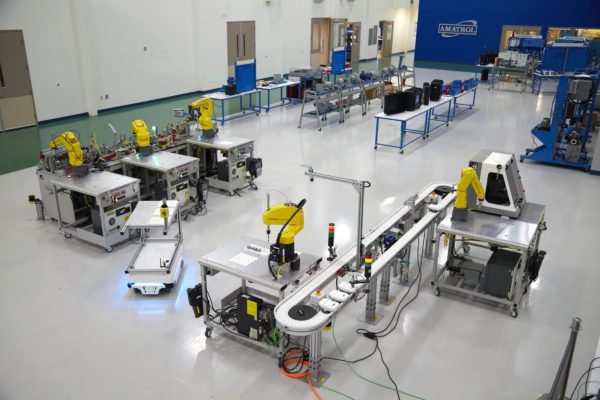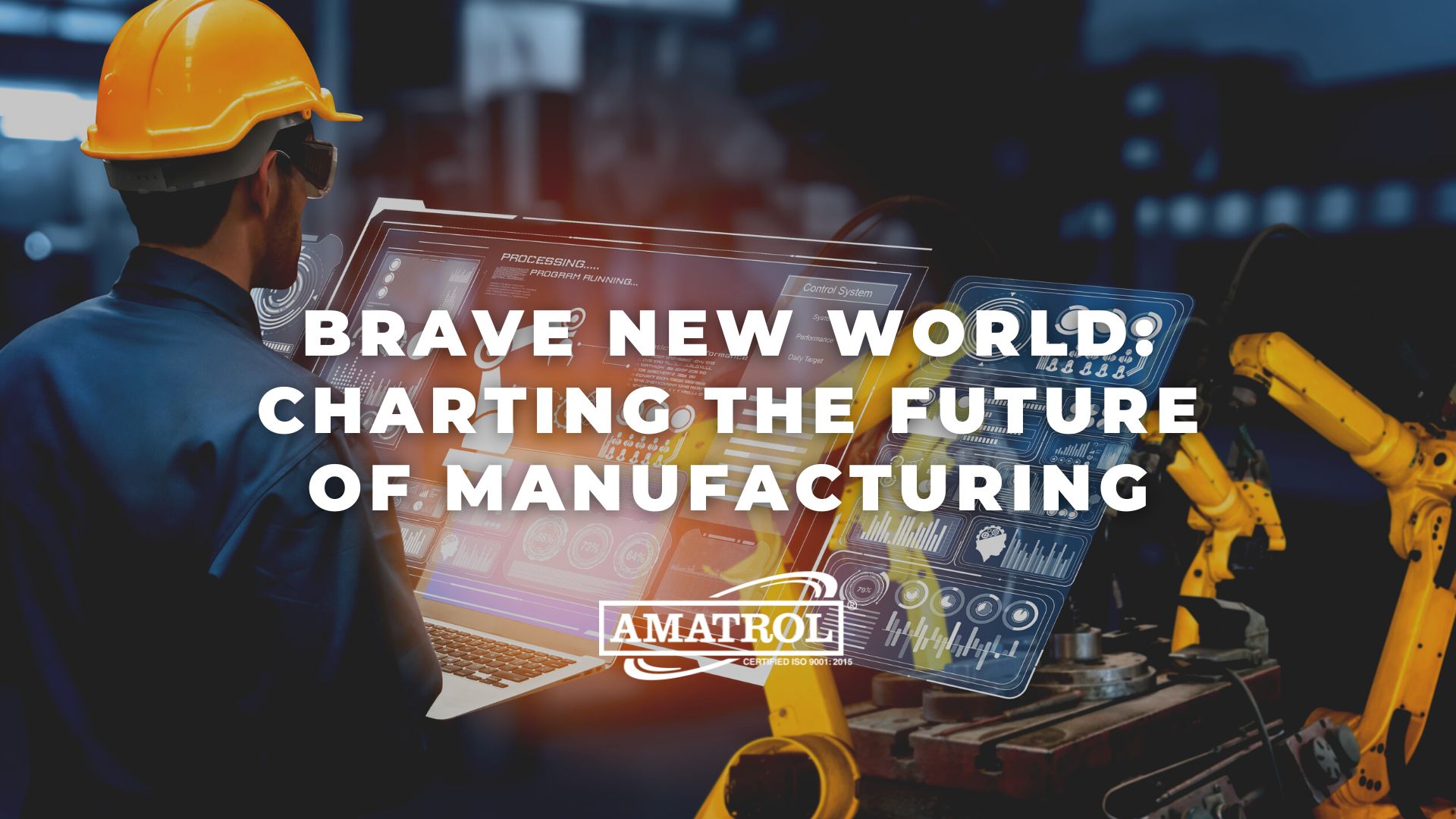When I was but a wee youngster, I vividly remember thinking about the future and wondering what marvels I would see in my lifetime. For some reason, I was certain that flying cars would be the norm by now.
Of course, today’s automobiles are still firmly grounded, although many of them are now electric. Can you think of a particular dream you had for the future that has not yet come to pass?
Now close your eyes and think about what manufacturing will look like a decade from now. Can you picture it? How does the factory floor of the future compare to today? What changes do you see taking place?
In this article, we’ll take a look at the predictions that have resulted from just such an exercise conducted by the National Association of Manufacturers’ (NAM) Manufacturing Leadership Council (MLC). We’ll also highlight Amatrol’s flagship Smart Factory Enterprise training system that’s designed to prepare your students and workers for the future of manufacturing.
Manufacturing in 2030
What will manufacturing look like in 2030? That’s the question NAM’s MLC asked, and now we have the answers in the form of the MLC’s Manufacturing in 2030 White Paper: The Next Phase of Digital Evolution (“MLC White Paper”).
In early 2021, the MLC “launched its Manufacturing in 2030 Project. The project’s main goal is to enable manufacturers to envision what manufacturing might look like by the year 2030.” This was not an easy task, as it “entails understanding the direction and velocity of technological trends associated with Manufacturing 4.0, the industry’s transition to the digital model of manufacturing. Perhaps most importantly, it entails identifying and understanding the challenges that all will face as the industry moves to the next stage of Manufacturing 4.0.”
Looking into a crystal ball to determine what the next decade holds for manufacturing is particularly daunting when you consider the changes that have taken place since 2010. As the MLC White Paper notes, “[m]any of today’s factories are almost unrecognizable compared to just 10 years ago. Today they are extensively automated, pervasively networked, constantly monitored and analyzed, flooded with data, and staffed by a workforce increasingly empowered by new digital tools.”
With so many advanced automation technologies already improving productivity and efficiency in manufacturing facilities across the country and around the globe, is there room for even greater technological strides? The MLC White Paper concludes that we haven’t seen anything yet.
Technology Advances Will Continue to Fuel Automation Adoption
The MLC White Paper doesn’t mince words when it summarizes the expected continuing impact of evolving technologies on the future of manufacturing: “Certainly, predicted developments in some of the key technologies underpinning the accelerating industrial digitization trend offer vast opportunities for both existing and new manufacturers to achieve greater efficiency, productivity, and increase global competitive differentiation over the coming decade.”
What are some of those technological advancements that will shake up the world of manufacturing? The MLC White Paper highlights a few:
“With a predicted trillion transistors on semiconductor chips by 2030, data volumes exploding between 200-500% in the next few years, quantum and nano-computing vastly increasing processing speeds, upcoming 6G networks supporting data rates of a terabyte a second, and increasingly advanced AI systems turning all that data into meaningful analytical insights in ever-more engaging visual ways, manufacturing’s potential to use these increasingly powerful digital tools to improve business outcomes is enormous.”
Realizing these benefits will require investments in a variety of areas, including equipment, software, and training human resources. The MLC White Paper summarizes some of these changes this way:
“New skills and roles will be needed to apply, operate, manage, and benefit from these new tools. New approaches to redefining human machine relationships will be needed for employees at all levels to best leverage advanced technologies for both personal and company improvement. And leadership teams will need to develop more digital acumen as they strive to master the vast amounts of data that will be available and harness the exponentially increasing digital power at their fingertips to create fruitful new business models and engaging customer experiences.”
New Technologies Will Create New Jobs
The MLC White Paper identifies five key areas of technology that will alter the landscape of manufacturing over the course of the next decade:
“The foundations of manufacturing digitization, which makes data a key asset from unit operations and machine tools to supply chains to manufacturing ecosystems, rests on five technological cornerstones: electronics, computer systems, software, communications technologies, and cyberinfrastructure. Taken together, developments in these technologies over the next decade and beyond will enable advances in human-machine interaction, automation and robotics, and autonomous operation.”
While all of these technological areas exist now, they are expected to grow and change in new and exciting ways. For example, here are just a few of the advances manufacturers can expect to see in the next decade:
- Intel projects “by the year 2030, it will be able to incorporate one trillion transistors on a single chip.”
- “Expected to become commercially available in 2030, 6G [cellular technology], which will purportedly support data rates of one terabyte per second, is expected to facilitate improvements in imaging, presence technology, and location awareness.”
- “But perhaps the most potentially significant technology for manufacturing’s future is artificial intelligence. AI, considered by MLC to be a pervasive technology, will increasingly be found in many types of applications and systems involved in manufacturing, from software applications used on the factory floor, to robotic systems used to help assemble products as well as move materials, to systems used in design, simulation, customer interactions, supply chain, and logistics, and many others.”
All of these technologies will need highly-skilled workers to operate, maintain, troubleshoot, and repair them. That means a variety of new roles will need to be filled in addition to the many open positions already available in manufacturing.
According to the MLC White Paper, “up to 65% of the job roles that will exist in 2030 don’t yet exist today. As alarming as that sounds, consider that 63% of jobs done in 2018 did not exist in 1940, according to the U.S. census. Many new manufacturing jobs will merely be an evolution of those that exist today – augmented by connected machines, AI, and advanced analytics.”
This may be concerning for some manufacturers who view finding highly-skilled employees as a challenge. Fortunately, the training experts at Amatrol are ahead of the curve on developing training systems to teach students and current workers the advanced automation skills they’ll need to succeed in the future manufacturing workspace.
How Amatrol Takes Automation Training to the Next Level
If you’re an educator looking to adequately train the next generation of manufacturing technicians or an employer needing to upskill your current workforce, you don’t have to recreate the wheel when it comes to hands-on skill training with advanced automation technologies.
Look no further than Amatrol’s Smart Factory Enterprise training system. Amatrol’s Smart Factory Enterprise represents true connected systems training at the enterprise level. Rather than providing discrete training systems focused on individual pieces, Amatrol’s Smart Factory Enterprise was designed to meet the need for hands-on training with a seamless system in which all the parts work together, just like learners will face on the job.
Click below to see Smart Factory Enterprise in action:
Using Amatrol’s Smart Factory Enterprise System, learners will gain real, relevant Industry 4.0 skills and experience, because they’ll be working with industry-standard components integrated in an enterprise system that replicates an authentic Smart Factory. Amatrol’s Smart Factory Enterprise represents a groundbreaking approach to teaching Industry 4.0 skills with a multi-station automated manufacturing system that integrates mechatronics, robotics, conveyors, autonomous robots, and a variety of other Smart Factory technologies.
Smart Factory Enterprise Teaches Hands-On Skills
Amatrol pioneered Industry 4.0 training when it transformed its popular full-scale mechatronics line into a robust Smart Factory training system. Today, the 870 Smart Factory Mechatronics system forms the backbone of the larger Smart Factory Enterprise system.
The Smart Factory is a fully connected and flexible manufacturing system that connects its physical systems, operational information, and human assets to control manufacturing, maintenance, inventory, and supply chain operations.
The linked mechatronics stations incorporate all major manufacturing technologies, including electrical, mechanical, hydraulics, and pneumatics. Together, the stations comprise a fully-automated manufacturing line that teaches essential processes, such as inventory control, inspection, sorting, assembly, torqueing, testing, CNC machining, and storage.
To transform this system into a true Smart Factory, Amatrol added a station for networking communications equipment, along with a variety of other connected technologies, such as: smart sensors; smart product ID; network communications & security; and smart production & maintenance software.
Building upon the foundation of Amatrol’s Smart Factory Mechatronics training system, the Smart Factory Enterprise adds the following real industrial components:
- Autonomous Robot System: Autonomous robots, also known as autonomous guided vehicles or AGVs, are changing the way products and parts are transported throughout Smart Factories. Using Amatrol’s Autonomous Robot System, learners will develop important Industry 4.0 skills, including how to program an autonomous robot to travel between stations to deliver necessary items on a precise schedule.
- Smart Robot Workcells: Amatrol’s Smart Robot Workcells allow users to integrate a variety of industrial FANUC robots with their Smart Factory Enterprise system. For example, the following FANUC robots can be used in conjunction with the Smart Robot Workcells: FANUC 200iD/4S, FANUC 200iD, and FANUC SCARA SR-6iA. The workcells also include a mobile workstation with a grid surface, a laser scanner, and an interface panel with discrete I/O/Ethernet, stacklight, and pneumatics.
- Smart Conveyor System: Conveyors play a major role in automated systems in manufacturing facilities around the world. Amatrol’s Smart Conveyor System teaches learners important applications, such as assembly, material handling, quality/inspection, and machine loading. In addition to a variable frequency drive (VFD), human-machine interface (HMI), and standard safety devices, the Smart Conveyor System interfaces with the Smart Robot Workcells and includes Industry 4.0 technologies, such as RFID pallet tracking and Ethernet communications.
If you’re ready to take your logistics training to the next level, consult with an expert at Amatrol today to learn how you can take the first step toward teaching the skills that will set students up for success in the future.
About Duane Bolin
Duane Bolin is a former curriculum developer and education specialist. He is currently a Marketing Content Developer in the technical training solutions market.





